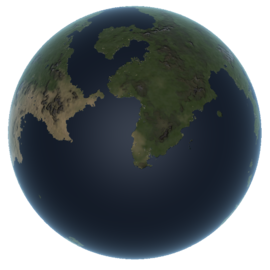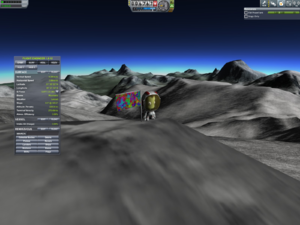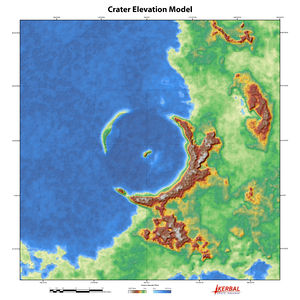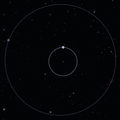Difference between revisions of "Kerbin/th"
m (thai lang category) |
|||
| (One intermediate revision by one other user not shown) | |||
| Line 231: | Line 231: | ||
{{Celestial Bodies}} | {{Celestial Bodies}} | ||
| − | [[Category:Celestials]] | + | [[Category:Celestials/th]] |
| − | [[Category:Planets]] | + | [[Category:Planets/th]] |
| + | [[Category:Thai Language pages]] | ||
Latest revision as of 01:29, 25 November 2021
| Kerbin | ||
| Kerbin as seen from orbit. | ||
| Planet of Kerbol | ||
| Orbital Characteristics | ||
| Semi-major axis | 13 599 840 256 m [Note 1] | |
| Apoapsis | 13 599 840 256 m [Note 1] | |
| Periapsis | 13 599 840 256 m [Note 1] | |
| Orbital eccentricity | 0 | |
| Orbital inclination | 0 ° | |
| Argument of periapsis | 0 ° | |
| Longitude of the ascending node | 0 ° | |
| Mean anomaly | 3.14 rad (at 0s UT) | |
| Sidereal orbital period | 9 203 545 s | |
| 426 d 0 h 32 m 24.6 s | ||
| Synodic orbital period | Not defined | |
| Orbital velocity | 9 285 m/s | |
| Physical Characteristics | ||
| Equatorial radius | 600 000 m | |
| Equatorial circumference | 3 769 911 m | |
| Surface area | 4.5238934×1012 m2 | |
| Mass | 5.2915158×1022 kg | |
| Standard gravitational parameter | 3.5316000×1012 m3/s2 | |
| Density | 58 484.090 kg/m3 | |
| Surface gravity | 9.81 m/s2 (1 g) | |
| Escape velocity | 3 431.03 m/s | |
| Sidereal rotation period | 21 549.425 s | |
| 5 h 59 m 9.4 s | ||
| Solar day | 21 600.000 s | |
| 5 h 59 m 60 s | ||
| Sidereal rotational velocity | 174.94 m/s | |
| Synchronous orbit | 2 863.33 km | |
| Sphere of influence | 84 159 286 m [Note 1] | |
| Atmospheric Characteristics | ||
| Atmosphere present | Yes | |
| Atmospheric pressure | 101.325 kPa | |
| 1 atm | ||
| Atmospheric height | 70 000 m | |
| 1.0×10-6 atm | ||
| Temperaturemin | -86.20 °C 186.95 K | |
| Temperaturemax | 15 °C 288.15 K | |
| Oxygen present | Yes | |
| Scientific multiplier | ||
| Surface | 0.3 | |
| Splashed | 0.4 | |
| Lower atmosphere | 0.7 | |
| Upper atmosphere | 0.9 | |
| Near space | 1 | |
| Outer space | 1.5 | |
| Recovery | 1 | |
|
| ||
เคอร์บิน เป็นบ้านเกิดของเคอร์บัล, เป็นที่ตั้งของศูนย์อวกาศเคอร์บัล, และเป็นจุดสำคัญของเคอร์บัลสเปซโปรแกรม. มันเป็นตัวแทนของโลกสำหรับเกมแต่มีดวงจันทร์สองดวง ชื่อ Mun และ Minmus.
เคอร์บินเป็นดาวลำดับที่สามในวงโคจรรอบดาวชื่อKerbol. มันเป็นวัตถุอวกาศที่ใหญ่ที่สุดอันดับสามที่โคจร Kerbol, following Jool and Eve. Jool's moon Tylo has the same radius of Kerbin, though it may be classified as larger, as the highest point on Tylo is about 5 km higher than the highest point on Kerbin. However, Tylo has only 80% of Kerbin's mass.
Reaching a stable orbit around Kerbin is one of the first milestones a player might achieve in the game. Doing so with a fuel-optimal ascent[1] requires a delta-v of ≈4500 m/s,[2] (or about 3500 if one is using Ferram Aerospace Research mod) and is the second highest value after Eve. Many interplanetary missions expend over half of their delta-V in reaching Kerbin orbit. The energy required to escape a body from a given altitude is always exactly twice the kinetic energy of a circular orbit around the body at that height, leading one observer to remark:
| “ | If you can get your ship into orbit, you're halfway to anywhere. — Robert Heinlein, quoted on page 194 of A Step Farther Out by Jerry Pournelle |
” |
Contents
In-game Description
| “ | A unique world, Kerbin has flat plains, soaring mountains and wide, blue oceans. Home to the Kerbals, it has just the right conditions to support a vast, seemingly undepletable population of the eager green creatures. Reaching a stable orbit around Kerbin is one of the first things budding space programs strive for. It is said that he who can get his ship into orbit is halfway to anywhere. — Kerbal Astronomical Society |
” |
Topography
Kerbin has a roughly equal distribution of surface liquid water and solid land, with polar icecaps and scattered deserts. Some of its mountains exceed 6 km in height, with the tallest peak being 6764 m in altitude at the coordinates 46.3° E 61.6° N. The lowest point is almost 1.4 km deep and about 313° south-west of the Kerbal Space Center.
Craters
Unlike other bodies in its system, Kerbin has few visible craters because its environment would erode craters from the few meteors that avoid the gravity or surface of its large moon and survive entry. Nevertheless, some geological formations indicate that bodies have violently collided with Kerbin: two planetary features appear to be impact craters that are coincidentally separated by nearly 180 degrees. The least eroded, and therefore presumably youngest, of the two (both are in excess of 100 km diameter) lies along the coastline. The uplift is easily visible as a series of islands, and the feature has a central peak that pokes up through the water (also known as a rebound peak.) The other, and older of the two, is near the prime meridian in the northern hemisphere and is more easily missed, but its uplift rims are visible, and it has a central rebound peak.
Biomes
Before 0.90 Kerbin was one of the few bodies with multiple biomes, Kerbin was second only to the Mun in number of biomes it has. Following the 0.90 update all celestial bodies have biomes. Science experiments can be performed at all biomes, though Kerbin's low multipliers result in less impressive results than more distant worlds. Kerbin's biomes show a loose correlation with Earth's biomes and geographic features. Uniquely, Kerbin has 33 location biomes at KSC, these are comprised of each building and their props, the crawlerway, the flag, and KSC itself; these give a jumpstart to gathering Science points in Career mode.
Planetary biome list
- Ice Caps
- Tundra
- Highlands
- Mountains
- Grasslands
- Deserts
- Badlands
- Shores
- Water
KSC location biome list
- KSC
- Administration
- Astronaut Complex
- Crawlerway
- Flag Pole
- LaunchPad
- Mission Control
- R&D
- R&D Central Building
- R&D Corner Lab
- R&D Main Building
- R&D Observatory
- R&D Side Lab
- R&D Small Lab
- R&D Tanks
- R&D Wind Tunnel
- Runway
- SPH
- SPH Main Building (Roof)
- SPH Round Tank
- SPH Tanks
- SPH Water Tower
- Tracking Station
- Tracking Station Dish East
- Tracking Station Dish North
- Tracking Station Dish South
- Tracking Station Hub
- VAB
- VAB Main Building (Roof)
- VAB Pod Memorial
- VAB Round Tank
- VAB Tanks
Atmosphere
Kerbin's atmosphere contains oxygen and extends to roughly 69,078 meters. Its atmosphere exponentially rarefies with altitude with a scale height of 5 km.[3] The atmospheric pressure on Kerbin at an altitude expressed in meters, generally is:
The thickness of Kerbin's atmosphere makes it suitable for aerobraking and using parachutes to save fuel during reentry and landing. Since version 0.19, harmless supersonic and shock heating/reentry effects have been applied to objects flying above certain velocities. Debris flying in the lower atmosphere disappears once 2 km from an active craft, but above approx. 23 km (where atmospheric pressure is less than 0.01 atm) debris persists. Spent stages may continue in a stable orbit even if they are going through thick atmosphere that would destabilize the orbit of an active craft[outdated].
The following table gives approximation of terminal velocities at different Kerbin altitudes, which are also the velocities at which a ship should travel for a fuel-optimal vertical ascent from Kerbin, given the game's model of atmospheric drag.[4] The optimal velocity after a gravity turn has been started is less than the corresponding value in the table.[5]
Terminal Velocity Table
| Altitude (m) | Velocity (m/s) |
|---|---|
| 75 | 100.8 |
| 1000 | 109.3 |
| 2000 | 119.3 |
| 3000 | 130.2 |
| 4000 | 142.2 |
| 5000 | 155.2 |
| 6000 | 169.4 |
| 7000 | 184.9 |
| 8000 | 201.8 |
| 9000 | 220.3 |
| 10000 | 240.5 |
| 12500 | 299.4 |
| 15000 | 372.8 |
| 20000 | 577.9 |
| 32000 | 1655.1 |
Orbits
A synchronous orbit is achieved with a semi-major axis of 3 463.33 km. Kerbisynchronous Equatorial Orbit (KEO) has a circularly uniform altitude of 2 863.33 km and a speed of 1 009.81 m/s. From a 70 km low equatorial orbit, the periapsis maneuver requires 676.5 m/s and the apoapsis maneuver requires 434.9 m/s. A syncronous Tundra orbit with eccentricity of 0.2864 and inclination of 63 degrees is achieved at 3799.7/1937.7 km. Inclination correlates with eccentricity: higher inclined orbits need to be more eccentric, while equatorial orbit may be circular, essentially KEO.
A semi-synchronous orbit with an orbital period of ½ of Kerbin's rotation period (2 h 59 m 34.7 s or 10774.7 seconds) is achieved at an altitude of 1 581.76 km with an orbital velocity of 1 272.28 m/s. A semi-syncronous Molniya orbit with eccentricity of 0.742[6] and inclination of 63 degrees can not be achieved, because the periapsis would be 36 km below the ground. The highest eccentricity of a semi-synchronous orbit with a periapsis of 70 km is 0.693 with an apoapsis of 3100.36 km.
The Hill sphere (the radius around the planet at which moons are gravitationally stable) of Kerbin is 136 185 km, or roughly 227 Kerbin radii.
Interplanetary Travel
From the lowest stable orbit around Kerbin (70 km), the amount of delta-V needed to reach the orbits of other celestials is:
| Body | Delta-V |
|---|---|
| Mun | ~860 m/s |
| Minmus | ~930 m/s |
| Eve | ~1033 m/s |
| Duna | ~1060 m/s |
| Moho | ~1676 m/s |
| Jool | ~1915 m/s |
| Eeloo | ~2100 m/s |
| Kerbol escape | ~2740 m/s |
For comparison, the Δv required to reach geostationary Kerbin orbit from LKO is 1.12 km/s
Reference Frames
| Time warp | Minimum Altitude |
|---|---|
| 1× | Any |
| 5× | 70 000 m (above the atmosphere) |
| 10× | 70 000 m (above the atmosphere) |
| 50× | 70 000 m (above the atmosphere) |
| 100× | 120 000 m |
| 1 000× | 240 000 m |
| 10 000× | 480 000 m |
| 100 000× | 600 000 m |
Gallery
Topographical map of Kerbin as of version 0.21
A projection map of Kerbin, as of 0.14.1 and before (including the old demo).
Topographical image of Kerbin from 0.17.1. The terrain is slightly different in the latest version.[7]
Changes
- Added biomes
- Biomes added.
- Terrain revised to produce more detailed and interesting landforms.
- Fixed ladders on the fuel tanks near the launchpad.
- New mesh for the launchpad and area (no launchtower anymore).
- New mesh for the runway, with lights and sloping edges for rovers.
- Terrain overhaul: Entire planet redo. Deserts, darker and greener grass, islands, darker ocean/water, snow capped mountains. Looks more realistic.
- Several Easter Eggs added.
- Airport added to island off of KSC coastline. (Not a launching point)
- Improved atmosphere visuals.
- Minmus added.
- Much more varied and taller terrain added. Prior to this, some mountain ranges exceeded 600 m in height, but the tallest point was at an altitude of approximately 900 m.
- Mün added.
- Terrain overhaul, oceans became wet.
- Atmosphere extended from ~34,500 m to ~69,000 m.
- Initial Release
Trivia
Kerbin's continents are derived from libnoise,[8] a coherent noise generating library, though they have been increasingly modified with time.
Notes
- ↑ A fuel-optimal ascent is one which (a) minimizes velocity losses to gravity and atmospheric drag and (b) launches eastward (toward the 90 degree heading) to gain 174.5 m/s of orbital velocity for free, thanks to Kerbin's rotation.
- ↑ See this challenge on the forum and a popular Kerbin delta-V chart
- ↑ Forum thread 16000, "[KGSS] Examining Kerbin's atmosphere"
- ↑ http://forum.kerbalspaceprogram.com/showthread.php/6664-Mini-challenge-max-altitude-with-this-supplied-spacecraft?p=100912&viewfull=1#post100912
- ↑ http://www.reddit.com/r/KerbalSpaceProgram/comments/1kov5z/a_handy_chart_i_made_for_the_most_efficient/cbrdvuo
- ↑ “Some Major Orbit Types” uses that, the Wikipedia article mentions 0.74105, and “Orbital Parameters of a Molniya Orbit” uses 0.72.
- ↑ http://forum.kerbalspaceprogram.com/entry.php/247-A-Brave-New-World
- ↑ http://libnoise.sourceforge.net/examples/complexplanet/























